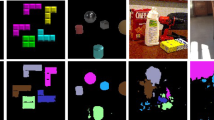Abstract
In computer vision tasks such as, for example, object recognition, semantically accurate segmentation of a particular object of interest (OOI) is a critical step. Due to the OOI consisting of visually different fragments, traditional segmentation algorithms that are based on the identification of homogeneous regions usually do not perform well. In order to narrow this gap between low-level visual features and high-level semantics, some recent methods employ machine learning to generate more accurate models of the OOI. The main contribution of this paper is the inclusion of spatial relationships among the OOI fragments into the model. For this purpose, we employ Bayesian networks as a probabilistic approach for learning the spatial relationships which, in turn, becomes evidence that is used for the process of segmenting future instances of the OOI. The algorithm presented in this paper also uses multiple instance learning to obtain prototypical descriptions of each fragment of the OOI based on low-level visual features. The experimental results on both artificial and real image datasets indicate that the addition of spatial relationships improves segmentation performance.





Similar content being viewed by others
References
Alam, F.I., Gondra, I.: A bayesian network-based tunable image segmentation algorithm for object recognition. In: Proceedings of IEEE International Symposium on Signal Processing and Information Technology, pp. 011–016 (2011)
Arthur, D., Vassilvitskii, S.: K-means++: the advantages of careful seeding. Technical Report 2006–13, Stanford InfoLab (2006)
Bhanu, B., Lee, S., Das, S.: Adaptive image segmentation using genetic and hybrid search methods In: IEEE Trans. Aerosp. Electron. Syst. 31(4), 1268–1291 (1995)
Bouman, C.A., Shapiro, M.: A multiscale random field model for bayesian image segmentation In: IEEE Trans. Image Process. 3(2), 162–177 (1994)
Carson, C., Belongie, S., Greenspan, H., Malik, J.: Blobworld: color and texture-based image segmentation using EM and its applications to image querying and classification. In: IEEE Trans. Pattern Anal. Mach. Intell. 24(8), 1026–1038 (2002)
Cooper, G., Herskovits, E.: A bayesian method for the induction of probabilistic networks from data. Mach. Learn. 9, 309–347 (1992)
Cormier, M., Gondra, I.: Supervised object segmentation using visual and spatial features. In: Proceedings of International Conference on Image Processing, Computer Vision and, Pattern Recognition, pp. 557–563 (2011)
Crandall, D.J., Huttenlocher, D.P.: Weakly supervised learning of part-based spatial models for visual object recognition. In: Proceedings of European Conference on Computer Vision, vol. 3951, pp. 16–29 (2006)
Dietterich, T., Lathrop, R., Lozano-Perez, T.: Solving the multiple-instance problem with axis-parallel rectangles. Artif. Intell. 89(1–2), 31–71 (1997)
Fan, J., Yau, D.K.Y., Elmagarmid, A.K., Aref, W.G.: Automatic image segmentation by integrating color-edge extraction and seeded region growing. In: IEEE Trans. Image Process. 10(10), 1454–1466 (2001)
Fergus, R., Perona, P., Zisserman, A.: Weakly supervised scale-invariant learning of models for visual recognition. Int. J. Comput. Vis. 71, 273–303 (2007)
Gondra, I., Xu, T.: A multiple instance learning based framework for semantic image segmentation. Multimed. Tools. Appl. 48(2), 339–365 (2010)
Gonzalez, R.C., Woods, R.E.: Digital Image Processing. Addison-Wesley Longman, Boston (2001)
Guy, G., Medioni, G.: Inferring global perceptual contours from local features. Int. J. Comput. Vis. 20(1–2), 113–133 (1996)
Heckerman, D.: A tutorial on learning with bayesian networks. In: Proceedings of the NATO Advanced Study Institute on Learning in, Graphical Models, pp. 301–354 (1998)
Maron, O., Lozano-Perez, T.: A framework for multiple instance learning. In: Proceedings of the Conference on, vol. 10. Advances in Neural Information Processing Systems, pp. 570–576 (1998)
Myung, I.J.: Tutorial on maximum likelihood estimation. J. Math. Psychol. 47(1), 90–100 (2003)
Neal, R.M.: Bayesian methods for machine learning. www.cs.toronto.edu/pub/radford/bayes-tut.pdf (2004)
Pearl, J.: Probabilistic Reasoning in Intelligent Systems. Morgan Kaufmann, San Francisco, California (1998)
Peng, J., Bhanu, B.: Closed-loop object recognition using reinforcement learning. In: IEEE Trans. Pattern Anal. Mach. Intell. 20(2), 139–154 (1998)
Sivic, J., Russell, B.C., Efros, A.A., Zisserman, A., Freeman, W.T.: Discovering objects and their location in images. In: Proceedings of the International Conference on Computer Vision, pp. 370–377 (2005)
Skiadopoulos, S., Koubarakis, M.: Composing cardinal direction relations. Artif. Intell. 152(2), 143–171 (2004)
Suzuki, J.: A construction of bayesian networks from databases based on an MDL scheme. In: Proceedings of the Conference on Uncertainty in Artificial Intelligence, pp. 266–273 (1993)
Todorovic, S., Ahuja, N.: Extracting subimages of an unknown category from a set of images. In: Proceedings of IEEE Conference on Computer Vision and, Pattern Recognition, pp. 927–934 (2006)
Vicente, S., Kolmogorov, V., Rother, C.: Graph cut based image segmentation with connectivity priors. In: Proceedings of IEEE Conference on Computer Vision and, Pattern Recognition, pp. 1–8 (2008)
Viola, P., Platt, J.C., Zhang, C.: Multiple instance boosting for object detection. Adv. Neural Inf. Process. Syst. 18, 1417–1424 (2006)
Walker, A.R., Pham, B., Moody, M.: Spatial bayesian learning algorithms for geographic information retrieval. In: Proceedings of the ACM International Workshop on Geographic, Information Systems, pp. 105–114 (2005)
Xu, T., Gondra, I., Chiu, D.: Adaptive kernel diverse density estimate for multiple instance learning. In: Proceedings of 2011 International Conference on Machine Learning and Data Mining, pp. 185–198 (2011)
Acknowledgments
This work was supported by a Discovery Grant from the Natural Sciences and Engineering Research Council (NSERC) of Canada.
Author information
Authors and Affiliations
Corresponding author
Rights and permissions
About this article
Cite this article
Gondra, I., Alam, F.I. Learning spatial relations for object-specific segmentation using Bayesian network model. SIViP 8, 1441–1450 (2014). https://doi.org/10.1007/s11760-012-0376-3
Received:
Revised:
Accepted:
Published:
Issue Date:
DOI: https://doi.org/10.1007/s11760-012-0376-3




